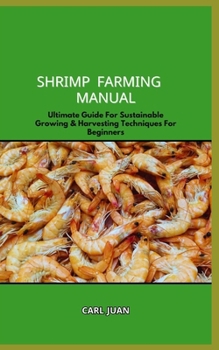SHRIMP FARMING MANUAL: Ultimate Guide For Sustainable Growing & Harvesting Techniques For Beginners
Aquaculture refers to the practice of raising marine organisms for human consumption, and shrimp farming is one such practice. Shrimp are bred, raised, and harvested in a controlled environment, such as a pond or enclosure. Due to its high demand and high economic value, shrimp farming has become an important economic activity in many countries.
The following are the common steps involved in shrimp farming:
- Site selection refers to the process of determining a farm's future home, which is typically a coastline or brackish water environment.
- The process of preparing a pond or other enclosure for the purpose of raising shrimp. The water's temperature, salinity, and quality must be controlled.
- Choosing a healthy seed stock of shrimp entails sourcing larvae or juveniles (often referred to as "seed" or "post larvae") from breeding facilities.
- Nutrition and feeding entails giving the shrimp the food they need to thrive and controlling how much they eat.
- Managing water is keeping water in a suitable condition by controlling variables such as dissolved oxygen, pH, and salt concentration. It's critical to have adequate aeration and filtration systems.
- Management and prevention of disease using strategies like routine observation, isolation, and antibiotics.
- Growth and Harvesting: Monitoring the shrimp's growth and ensuring adequate conditions for development. When the shrimp have reached the appropriate size, they are harvested using nets or other devices.
- The term "processing and marketing" refers to the steps taken after a shrimp harvest to prepare the catch for sale to the general public.
Shrimp farming can be done on a wide range of scales, from backyard operations to multimillion-dollar corporations. Shrimp, a delicacy enjoyed in many cultures, has helped boost the worldwide fish business. There have been attempts to create more sustainable and environmentally responsible shrimp farming practices, such as integrated multi-trophic aquaculture (IMTA) and better farm management techniques, in response to issues with sustainability, environmental impact, and disease management.
The following are the common steps involved in shrimp farming:
- Site selection refers to the process of determining a farm's future home, which is typically a coastline or brackish water environment.
- The process of preparing a pond or other enclosure for the purpose of raising shrimp. The water's temperature, salinity, and quality must be controlled.
- Choosing a healthy seed stock of shrimp entails sourcing larvae or juveniles (often referred to as "seed" or "post larvae") from breeding facilities.
- Nutrition and feeding entails giving the shrimp the food they need to thrive and controlling how much they eat.
- Managing water is keeping water in a suitable condition by controlling variables such as dissolved oxygen, pH, and salt concentration. It's critical to have adequate aeration and filtration systems.
- Management and prevention of disease using strategies like routine observation, isolation, and antibiotics.
- Growth and Harvesting: Monitoring the shrimp's growth and ensuring adequate conditions for development. When the shrimp have reached the appropriate size, they are harvested using nets or other devices.
- The term "processing and marketing" refers to the steps taken after a shrimp harvest to prepare the catch for sale to the general public.
Shrimp farming can be done on a wide range of scales, from backyard operations to multimillion-dollar corporations. Shrimp, a delicacy enjoyed in many cultures, has helped boost the worldwide fish business. There have been attempts to create more sustainable and environmentally responsible shrimp farming practices, such as integrated multi-trophic aquaculture (IMTA) and better farm management techniques, in response to issues with sustainability, environmental impact, and disease management.
Format:Paperback
Language:English
ISBN:B0CRXZPQ1V
ISBN13:9798875523090
Release Date:January 2024
Publisher:Independently Published
Length:56 Pages
Weight:0.14 lbs.
Dimensions:0.1" x 5.0" x 8.0"
Customer Reviews
0 rating





